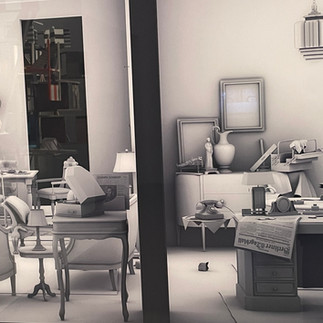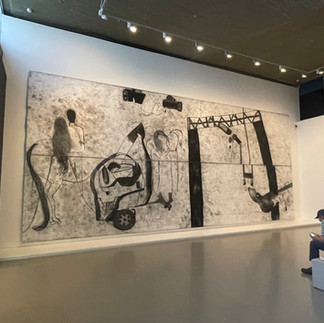Jerusalem a pendulum (or a crane)
- mcohe7
- Sep 9
- 4 min read

A view of Jerusalem center that tells you all you need to know about how this city has developed. The low buildings and the tiled roof buildings date from the late 19th century to the 1930s. In the late 1800s this was one of the first areas outside the old city to be developed and was walled in mostly by the buildings themselves. They are still occupied. In the 1930s when Palestine was occupied by the British the next level of buildings (with red roofs) were built and are also still standing and occupied for the most part though some are undergoing renovation. Then you have the massive apartment buildings and the always present cranes (national bird of Israel many say).
My first trip to Israel was in 1967 and we were housed at the Israel Goldstein Youth Village that was located outside of Jerusalem with nothing around it, and we had to walk a good ways just to get a bus to go downtown. Now the city of Jerusalem completely surrounds the Village. Unknown to me until this trip, originally the village had 20 dunams of land for agriculture. A dunam is a measure of land used in the former Turkish empire (of which Israel was once also a part of) that is equivalent of 5 acres. As the city encroached now they have 2 dunams or 1/2 acre. The daughter of a friend is now the development director at the school and gave us a tour of what they now grow mostly to teach the students who live there about agriculture. Some very ingenious growing techniques! The school is mostly a boarding school that attracts students from around the world including most recently from Ukraine and Russia.

One of my all time favorite museums, the Israel Museum has some of the finest collections of archaeology, cultural artifacts, and fine art in the world. They are celebrating their 60th anniversary this year which means the museum was only a few years old the first time I came here.
Ai Wei Wei’s bronze trees in front of the Shrine of the Book (containing the Dead Sea Scrolls), Zadok ben-David, “Horse Power” from 1999, and a small courtyard with an ancient olive tree and a Calder stabile sculpture to complete the space. We saw several fascinating shows while we were there.
This exhibit fused different styles of silver work from Jewish communities around the world from the collection of silver objects in the Bezalel art school. The Bezalel art school would be equivalent to the Chicago Art Institute art school. The artist of these video works created hybrids that evoke social and political questions. What I can’t show you here is that these images were in motion, swinging, lighting up, swiveling, etc. It was quite engaging.
A more provocative exhibition was entitled “The Swing of the Pendulum”. The introduction states ”Between war and its absence, existential fear triggering past traumas, and the moral routines of a healthy society, life in Israel resembles a swinging pendulum…from the early 20th century to the present day. Left: Nahum Guzman, “Sheaving the Wheat”, 1926, Center: Michal Rover, “Trio” and “Duo, 2024 video, Right: Dana Levy, “Disengagement”, 2005
This work recreates, with the help of engineered images, the interior of a Berlin home, a moment before it was abandoned on the eve of WWII. Based on the written memoirs of Yair Noam, who grew up in Berlin and escaped to Palestine in 1938.
Left: Elie Shamir, “Self Portrait Painting the Landscape”, 2001, Center: Village of Nahalal Birds Eye view with equally sized plots of tilled earth expresses the pioneer spirt of Israel’s first workers’ settlement, Right: detail of the bronze sphere
Maria Salem Mohamed, “Ana Hoon, I am Here”, 2019. Personal and collective narrative- a car crash, a wedding, the artists own handprints as if we were looking at a prehistoric cave painting. Maria is an Israeli Palestinian artist. There were several in the show, found this work the most interesting.
Absalon, “Solutions” 1992 video and model dwelling (exterior and window looking in). The artist who died very young from HIV said “I would like to create my own setting and belong to nothing else. My living unit will be comprised of the six habitation units which I construct and my homeland will be in-between them.”

Two parallel realities, Ukraine in 1991at the end of the Soviet era, a violent and unstable time and Be’er Sheva in the same year during the first Gulf War when many Jews arrived in Israel from the former Soviet Union. It emphasizes the differences in locale though both harsh and uninviting. The artist is Zoya Cherkassy “Friday in the Projects”, 2015.

“First Fruits” by Reuben Rubin, one of Israel’s most famous artists was painted during his first year in Palestine early in the 20th century. For Reuben the land was a paradise filled with harmony and fertility. How things have changed.

This video which also included sound is a frenetic dance and unexpected movements created using magnetic force. Shreds of vegetation, pieces of dry wood, had magnets attached and placed on a table to which large magnets were attached. It creates a moving still-life. Sasportas, the artist creates a sense of unpredictability and potentially danger.

The third exhibit we saw is one designed for children in the archaeology section of the museum but how timely for those of you in the ancient Art History class who are either learning about ancient Egypt or will very soon. The subject is animals in Egyptian art both actual and fantastical.
Left: Coffin of a mummified Ibis, 2390 BCE, Center: Winged scarab and two falcon heads on a collar, 2000 BCE, Right: Coffin of a mummified cat, manifestation of the goddess Bastet, 2350 BCE. In the background to the left is a mummified catfish.
































































Comments